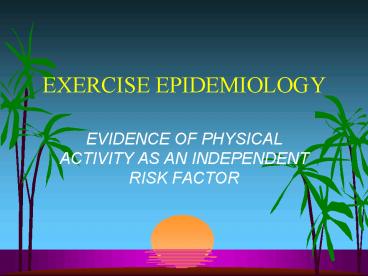EXERCISE EPIDEMIOLOGY
1 / 11
Title: EXERCISE EPIDEMIOLOGY
1
EXERCISE EPIDEMIOLOGY
- EVIDENCE OF PHYSICAL ACTIVITY AS AN INDEPENDENT
RISK FACTOR
2
EPIDEMIOLOGY-Definition
- Study of frequencies distributions of disease
in human populations. - Establish cause of disease means of its spread
and mechanism for its surveillance. - Comparison Contrast- see if groups
characterized in one way (i.e, active vs
inactive) can be differentiated by another factor
(risk or occurrence of cardiovascular heart
disease).
3
Principles Applied in Research
- Statistical Association-significance between
presumed cause effect. - Temporal Sequence-assessed cause preceded the
effect. - Consistency- Findings cross age, gender, race,
occupation, geography, economic status. - Persistence-Follow-up studies should find similar
trends.
4
EPIDEMIOLOGY PRIN. CONT.
- Independence- In spite of other factors, does the
exercise/CHD relationship hold. - Dose-response-Does more exercise lower CHD.
- Specificity-exercise affects CHD more than any
other disease (maybe types of cancer). - Alterability-application of dose-response.
- Repeatability- multiple findings similar.
- Confirmation-Physiological consequence.
5
Relative Risk Concept (RR)
- Compare the incidence of CHD of sedentary vs
active population. If active group has lower
incidence then RR is lt1.00. Higher incidence
results in RRgt1.00. - Confidence Interval- 95 CI means only 5 chance
results aren't truly different. Sets upper and
lower limits for separating RR in groups.
Researchers report both RR and CI data.
6
Types of epidemiological studiesI.
snap-shot-x-sectional.
7
II. flashback-retrospective or casecontrol
study
- Recall personal histories of past phsical
activity. - Compare disease vs disease free group in terms of
past activity. - bias from already knowing outcome.
- Casdecontrol pairs of older Floridians.
- 568 pairs- 322 controls more active than cases.
- As casecontrol activity score 1.0, risk
0.83.When score gt5, risk0.50. - Scoregt10, risk0.30
8
III. Motion Picture-Prospective
- Harvard Alumni-started in 1960, repeat collection
through 1990s. Obtain data in advance of
outcomes. - Statistical association-Inc. activity Dec. risk
- Consistency-All age groups.
- Persistence- Several follow-ups
- Dose-response- Activity kcal and CHD rate
- Independence- correct for other risk factors.
9
IV. Time-Lapse Experimental
- Randomized clinical trial-Take group and assign
activity or sedentary lifestyle. - Exercisers-1.9 developed CHD vs 4.3 in
control. - All MI- 5.3 vs 7.0
- Non-fatal MI- 4.5 vs 3.4
- MI death- 0.3 vs 2.4.
10
V. Rerun, hypothetical
- What if groups had led better lives? What might
be impact on changing CHD in population?
11
VI. Futuristic-predictive
- How might longevity be affected with changing
activitiy. Do you gain years based on making a
sedentary person active. - Need to use inactive vs active people for
projection. - 2.15 yr gain estimated for sedentary person who
becomes active.































